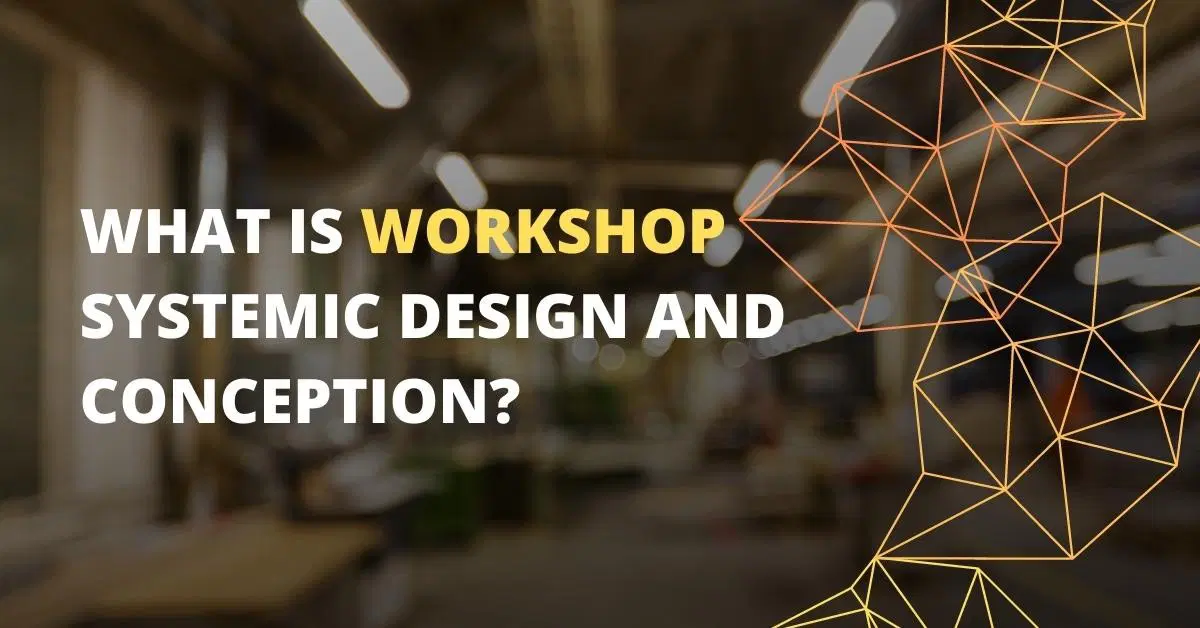
A systemic approach is essential in the case of systemic co-creation. The systemic conception and design process can address both systemic pathology and systemic change. This systemic pathophysiological approach is focused on creating interventions that are aimed to have positive systemic effects, generally at the group level. The systemic design process has been designed for this purpose by designers committed to social change, so it can be used to create ecosystems, missions, organizations, etc., to achieve desirable worldwide effects.
This systemic pathophysiological approach is entirely different from conventional diagnostics aimed at isolating causes of pathology within single systems or subsystems. It is also qualitatively different from systemic therapy approaches based on isolating causes of dysfunctionality and curing them one by one. The systemic co-creation workshops propose systemic interventions that correspond to systemic change instead of systemic pathology, which is usually addressed in systemic therapy approaches. These systemic co-creation workshops use systemic design principles and tools, such as atmospheric mapping, systemic diagnostics, and systemic strategies creation. These systemic design tools enable large-scale systemic initiatives that contribute to the emergence of new ecosystems or paradigms for societal development.
This approach applies both to building strong organizations with a strong identity capable of having a long-lasting impact on various levels (community, region, country) and can be effective in creating innovative solutions at the level of specific problems within communities cities (such as healthcare services). The systemic co-creation workshops are usually systemic pathophysiological approaches that include systemic diagnostics of current systemic conditions, systemic strategies for systemic change, and the systemic design of systemic solutions.
Applied Systemic Approach to Workshops
The systemic approach is applied to workshops’ subsystem conception and design. The systemic methodology proposed here allows systemic planning of systemic workshops that produce endogenous products under systemic properties. This paper presents a theoretical study on systemic seminars based on the methodological principle developed in 2009 by the Abordagens Sistêmicas association led by Jorge Luiz Torelli. According to Magalhães (2009), the systemic methodology is part of a more extensive research program developed by the Abordagens Sistêmicas association, which began in 2009 to produce theoretical results. If you want to learn workshop design and conception with systemic approach, you can join IIENSTITU's course.
What Is Workshops Systemic Design?
Systemic design is a systemic approach to design. Systems thinking and systemic principles are applied in the whole process, from innovation to product or service implementation. The workshop was developed by Andrea Branzi as part of his systemic design agenda at Domus Academy, Milan, which he founded as president.
In systemic workshops, participants follow a six-step systemic method that leads them through the systemic design process:
Observation,
Analysis (based on Alexander's pattern language),
Conceptual synthesis (patterns into system models),
Prototyping (models into prototypes),
Testing (prototypes with users),
Implementation (prototypes become actual products).
Although the workshop focuses mainly on ideation processes, it also provides tools for implementation, product improvement, and feedback. Branzi developed systemic workshops as a systemic alternative to the traditional design thinking approach that originated in engineering and later became part of industrial design education. The systemic approach was introduced into design by Branzi, Andrea Branzi, and Franco Teodoro in 1965 at Domus Academy to overcome traditional compartmentalization:
“Today systemic thought is considered one of the theoretical foundations for research and development in architecture and town-planning, but it has yet to establish itself firmly within industrial design.” In systemic workshops, systemic tools are used during ideation, in particular systemic patterns, representing a systematic account of practical problems that frequently recur in the natural or human-made environment. They are systemic analogs of the traditional practices used in architecture and product design since the 1970s. The systemic method has been applied to several fields:
"The systemic project is a system which operates as an active structure able to influence its own internal environment and interact with its external surroundings… The actions within this overall systemic project should be designed as systemic experiments aimed at studying environmental context for further systemic strategy elaboration."
“The purpose of designing systems is not to create products but rather to determine new systemic relationships between man and his environment that go beyond the simple production of objects.”
The systemic method was applied in a systemic workshop in Thailand in 2014 and a systemic project in Taiwan in 2016.
What Are Systemic Workshops?
The systemic workshops are systemic conception tools born out of systemic psychoanalysis, part of the systemic family. The systemic family is a field that has developed in the past half-century. It includes systemic psychotherapy, systemic coaching, systemic work with groups and organizations, systemic consulting around issues linked to the organization-systemic management-systemic leadership- systemic education... But each member of this "family" uses its own methodology, tools, and techniques!
Related Course: Leadership Course
As far as systemic workshops are concerned, they rely on three main ideas: - reality is neither subjective nor objective but relational;
There are no individual phenomena or collective phenomena, but phenomena that are always "relational," i.e., existing between several agents, between several subjects. For systemic workshops, working at systemic level implies putting oneself in relation with the other (ergo systemic) to understand what happens between us;
"Systemic" is not the same as systemic thinking - systemic workshops use systemic tools and systemic conception processes which are different from systemic thinking;
The systemic concept goes far beyond systemic thinking. It refers to all that has no name or has yet to be named, which remains unarticulated because it does not comply with our usual ideas of reality. Staying at this level also involves risking losing one's way without finding another! Consequently, sustaining a movement within systemic implies moving away from simplicity towards complexity.. which requires tools for making things simple again to be able to work on them;
Systemic workshops put systemic tools and systemic conception processes at the service of systemic practices.
This is another way of saying that systemic tools and systemic conception processes must, before anything else, facilitate systemic practices, i.e., help us better understand our relational reality and operate within it.
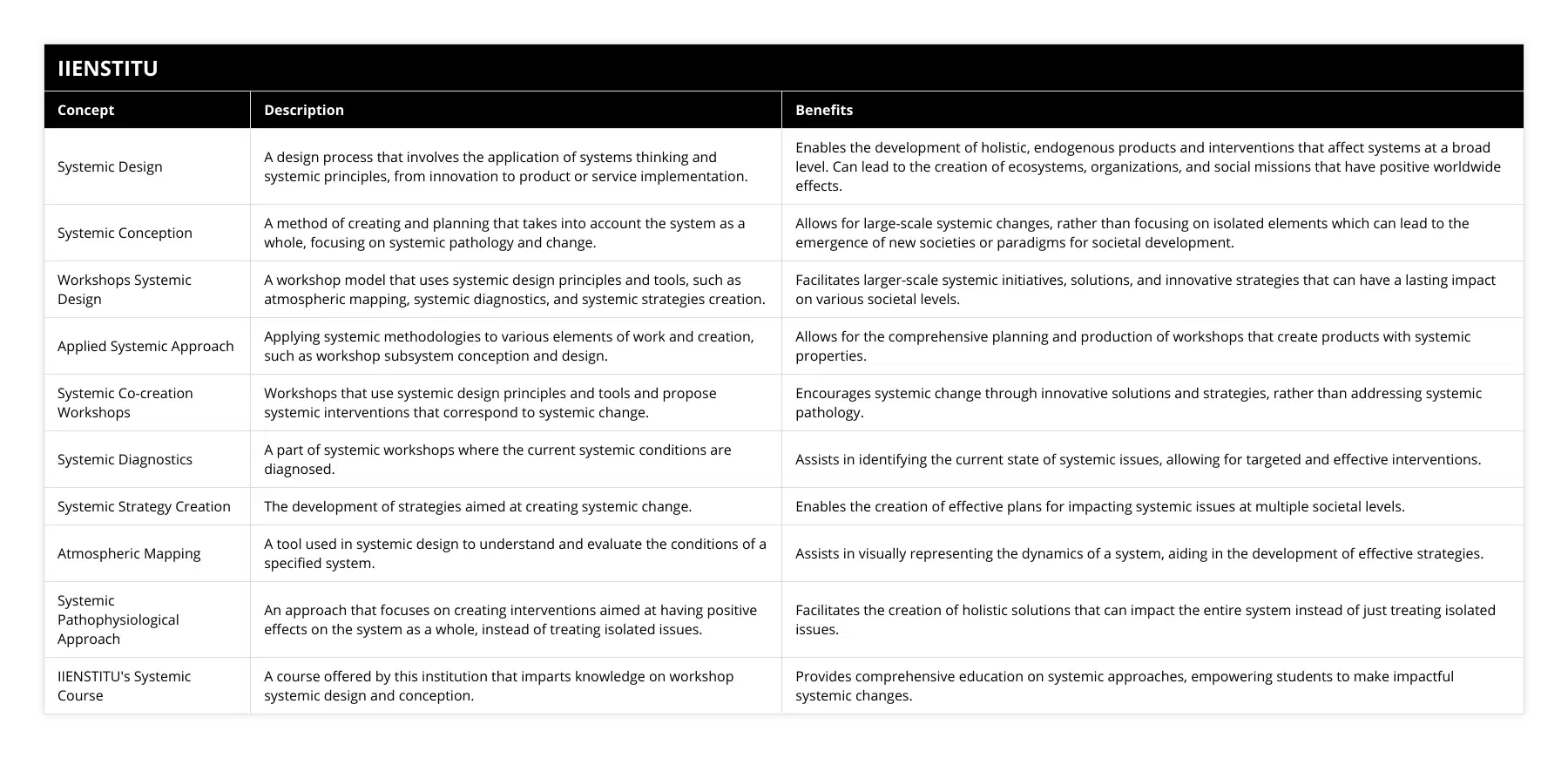
Frequently Asked Questions
What are the key factors that contribute to climate change?
Key Factors Contributing to Climate Change
There are several key factors that contribute significantly to climate change. The most significant is the burning of fossil fuels such as coal, oil and natural gas. When fossil fuels are burned, they release greenhouse gases like carbon dioxide and methane into the atmosphere. These greenhouse gases trap heat from the sun, causing global temperatures to rise.
Deforestation is another major factor. Trees absorb and store carbon dioxide. When forests are cleared, that stored carbon is released. Deforestation also reduces the number of trees available to remove carbon dioxide from the air. Between 2015 and 2020, the world lost over 4 million hectares of forest per year.
Intensive livestock farming generates significant greenhouse gas emissions. Cows and sheep produce methane as part of their digestive process. Large scale cattle ranching leads to deforestation too. The livestock sector accounts for around 15% of global emissions.
Other contributors are fertilizers containing nitrogen and the burning of biomass. Overall, human activities are responsible for almost all of the increase in greenhouse gases over the last century. To mitigate climate change, we must transition from fossil fuels to renewable energy and prevent further deforestation. We must also reduce emissions from agriculture and other sources.

How does gender inequality manifest in different cultures?
Manifestations of Gender Inequality
Gender inequality refers to unequal treatment or perceptions of individuals based on their gender. This manifests in various ways across cultures. In many cultures, traditional gender roles cast women as caregivers and men as leaders. This leads to inequalities in domestic duties, employment, and positions of authority. For example, in parts of South Asia, women spend much more time on unpaid domestic work than men. In Saudi Arabia, strict laws prohibit women from traveling or working without a male guardian's permission.
Gender discrimination in education also perpetuates inequality. In Afghanistan, girls face barriers to attending school including lack of facilities, child marriage, and Taliban restrictions. Only 37% of Afghan girls complete primary education, compared to 66% of boys. This lack of education limits women's ability to participate in society.
Violence against women is another manifestation of gender inequality. Practices like female genital mutilation in parts of Africa, acid attacks in Southeast Asia, and honor killings in the Middle East target and control women. Up to 38% of murders of women worldwide are committed by intimate partners. Laws and enforcement often fail to protect women.
While many cultures have embedded gender inequalities, increased education for women and girls, activism, and legal protections are working to promote equal rights. Achieving gender equality requires changing long-held biases and practices.

What policies can governments implement to reduce poverty?
Policies to Reduce Poverty
Governments can implement several policies to help reduce poverty. One important policy is to increase access to education. Governments can make primary and secondary education free and compulsory. They can also provide subsidies and scholarships to help low-income students attend college or vocational schools. Education gives people the skills needed to obtain better-paying jobs.
Another policy is to create more jobs and improve wages. Governments can invest in infrastructure and green technology to create construction and manufacturing jobs. They can set higher minimum wages and strengthen unions to improve pay. Policies that support small businesses can also lead to more job creation.
Governments can also strengthen social safety net programs. They can provide cash assistance, food stamps, and housing vouchers to help families meet their basic needs. Healthcare subsidies can make insurance more affordable. Increasing funding for childcare, disability, and unemployment benefits further aids those struggling financially.
Lastly, governments can reform tax policies to ease the burden on lower-income households. They can make tax systems more progressive by increasing taxes on the wealthy. Tax credits like the Earned Income Tax Credit can supplement wages for workers. Reducing regressive payroll and sales taxes helps increase take-home pay.
Implementing a mix of education, job creation, safety net, and tax reform policies can significantly reduce poverty. A comprehensive approach addresses both the symptoms and root causes of financial hardship for low-income families and individuals.

What are some examples of systematic design in engineering projects?
Systematic design is an important part of engineering projects. It involves carefully planning and organizing the design process to achieve the desired goals and optimize performance. Some examples of incorporating systematic design in engineering projects include:
Defining project requirements and constraints
Engineers first need to fully understand the requirements, specifications, and constraints of a project. This involves working with stakeholders to define the problem to solve, performance criteria, budgets, deadlines, and other limitations. Having clear project requirements from the start allows for an optimized design process.
Researching existing solutions
Performing research on current solutions, competing designs, and past projects with similar parameters helps engineers make informed decisions. This background knowledge prevents repeating past mistakes and builds upon proven design concepts. Research identifies potential opportunities and challenges to address in the design.
Creating alternative design concepts
Engineers typically develop multiple alternative design concepts through brainstorming and ideation techniques. Generating various options allows them to compare and select an optimal design direction. This exploration phase aims to find innovative design solutions within the project's limits.
Analyzing designs through prototyping
Creating prototypes and models allows testing of design concepts through simulation and experimentation. Engineers can analyze factors like structural integrity, functionality, usability, and performance. This provides empirical data to guide design improvements and validate theoretical concepts.
Optimizing through iteration
An iterative process of testing, analyzing, and refining design prototypes enables optimization. Engineers methodically improve their design by learning from failures, identifying flaws, and finding solutions. Several iterations are often needed to achieve the required technical specifications and performance standards.
In summary, systematic design incorporates definition of requirements, research, ideation, prototyping, and iteration. This phased approach allows engineers to logically plan, develop, test, and improve designs to meet project goals and end-user needs.
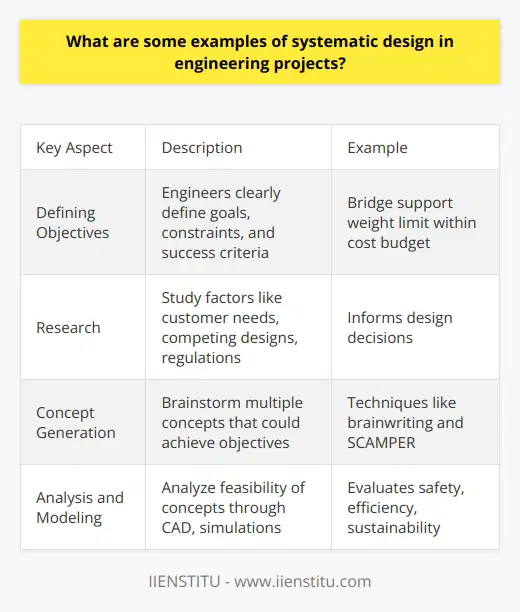
How can systematic design improve the development process for new products?
Systematic design is a structured approach to developing new products that involves clearly defining project goals, gathering user insights, concept generation and evaluation, prototyping, and testing. Employing systematic design in the product development process can lead to more successful outcomes by ensuring the product meets user needs, aligns with business goals, and follows best practices. There are several ways that utilizing a systematic design methodology improves new product development.
Defining project goals and constraints upfront aligns stakeholders on priorities and guides decision-making. Rather than jumping straight into design, taking the time to clarify the target users, business objectives, budget, timeline, and success metrics keeps the team focused. This upfront alignment saves time and resources down the line. For example, agreeing that the priority feature set for a new smartphone is battery life and camera quality steers concept generation and prototyping accordingly.
Researching user needs provides crucial insights that inform design decisions. Using surveys, interviews, observation, and secondary research to understand user behaviors, frustrations, and desires ensures the product solves real problems. Testing concepts and prototypes with actual users also validates assumptions and identifies areas for improvement. For instance, user research could reveal that the top frustrations with existing smartphones are short battery life and blurry low light photos.
Exploring a wide range of concepts before committing to a design direction prevents getting stuck on early ideas. Brainstorming sessions, sketching exercises, and ideation techniques lead to more innovative solutions. Comparing multiple concepts also identifies the strongest ideas to pursue and helps work through potential design trade-offs. For example, exploring concepts focused on battery, camera, size, and style could uncover an elegant, slim design with a high-capacity battery and camera lens innovations.
Prototyping brings ideas to life to test functionality, usability, and feasibility. Simple prototypes provide valuable feedback on concepts before investing in full development. They also aid communication between team members and stakeholders. Prototypes can range from paper sketches to 3D-printed models to digital mockups. Testing prototypes with users reveals areas for refinement and provides confidence in design decisions. For instance, a 3D printed model could validate the ergonomics and slimness of the proposed smartphone design.
Methodical testing throughout the design process identifies flaws to fix and opportunities to improve the user experience. Lab usability studies, beta testing, and collecting qualitative feedback from users help optimize and finalize the design. Testing also ensures the product delivers on goals and meets quality standards before launch. For example, user testing may reveal difficulties accessing the power button on early prototypes leading to a design change.
By taking a systematic approach of defining, researching, ideating, prototyping and testing, product teams can maximize results. The intentional process leads to designs that truly address user and business needs. It also builds team alignment and produces documentation to inform development. Establishing these best practices for new product design enhances innovation capabilities and ultimately leads to more successful product launches.
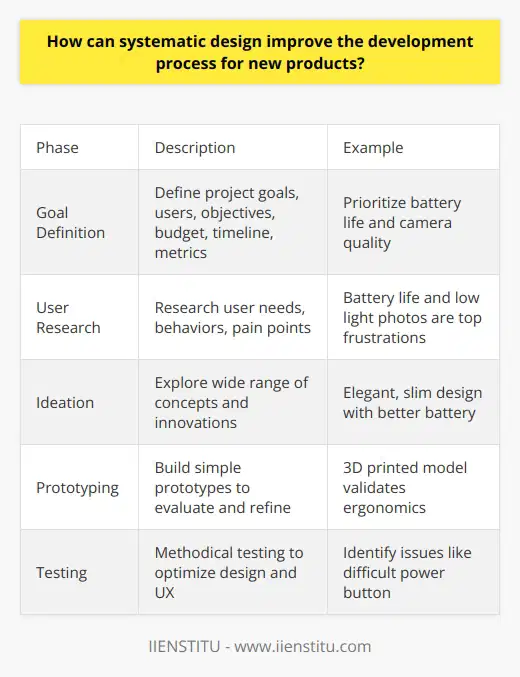
In what ways does a systematic design approach allow for more effective testing and refinement?
Benefits of a Systematic Design Approach
Adopting a systematic design approach provides several advantages that allow for more effective testing and refinement of products. Firstly, it enables a methodical process of identifying requirements and constraints early on. Developers can analyze the problem, understand user needs, and define objectives upfront. This clarity of goals guides downstream efforts. Secondly, systematic design facilitates breaking complex problems into smaller, more manageable pieces. Rather than tackling an entire system at once, developers can progressively build and test individual components. This modular approach localizes errors and simplifies troubleshooting.
Additionally, systematic design encourages creating prototypes and simulations before full implementation. Building simplified models validates assumptions and functionality without investing heavily upfront. Rapid iterations based on testing these prototypes allow quickly honing the design. Systematic approaches also emphasize regular peer reviews and collaboration. Cross-functional input from colleagues with diverse perspectives further enhances the quality and completeness of the end product. Overall, the structured thinking, phased testing, and continuous refinement intrinsic to systematic design results in robust and resilient solutions.
In summary, decomposing complex problems, prototyping, early and iterative testing, reviews, and cross-functional collaboration make systematic design approaches highly effective. These practices reduce risks and costs while allowing products to better satisfy customer needs. A systematic approach leads to superior outcomes compared to ad hoc efforts. Organizations would benefit greatly from instituting systematic design thinking and processes.
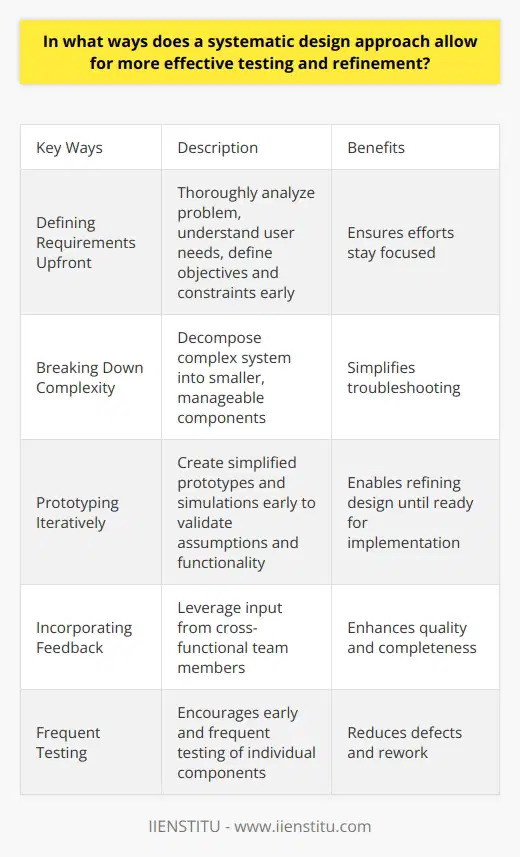
What is the purpose of the Systemic design Association?
The Systemic Design Association (SDA) is a non-profit organization founded in 2015 that aims to advance systemic design as an emerging area of design theory and practice. Systemic design takes a holistic approach to complex design challenges by considering the relationships, perspectives, and boundaries between systems. The SDA seeks to connect systemic design practitioners, students, teachers, researchers, activists, organizations, and funders across disciplines and sectors. Through systemic design, the SDA hopes to catalyze systems and social change towards more sustainable, resilient, and equitable futures.
The SDA pursues its mission through several key activities. First, it hosts an annual international systemic design conference to convene the systemic design community. The multi-day conference features keynotes, paper presentations, workshops, exhibitions, and networking opportunities. Second, the SDA publishes the Systemic Design Research Network, an open access, peer-reviewed academic journal focused on systemic design. This provides an important platform to develop systemic design theory and share applied research. Third, the SDA organizes regional events, such as lectures, workshops, and design charrettes. These allow for more accessible and regular interactions between systemic designers to exchange ideas and collaborate. Fourth, the SDA undertakes advocacy and partnership development to promote the uptake of systemic design in industry, government, education, and civil society organizations. Finally, the SDA administers a website, newsletter, and social media channels to engage its international membership and disseminate systemic design knowledge.
Through these activities, the SDA cultivates systemic design as an emerging transdisciplinary practice oriented towards systems change and sustainability. It brings together diverse perspectives to develop systemic design theory and practice. The SDA provides systemic designers with networking, learning, and collaboration platforms to apply a systems mindset and human-centered approach to complex socio-technical problems. Its ultimate vision is the widespread adoption of systemic design to create integrated solutions that consider diverse stakeholders, foster participatory processes, and promote systemic changes towards more just, resilient, and sustainable futures.
How does one become a member of the Systemic design Association?
Becoming a member of the Systemic Design Association (SDA) is a straightforward process that allows designers, researchers, educators, students, and professionals from all disciplines to join a community focused on systemic design. The SDA aims to advance systemic design research, education, and practice. It was founded in 2015 by people from various countries and backgrounds who shared an interest in systemic design.
To become a member, you first need to create an account on the SDA website (www.systemic-design.net). This involves providing some basic information about yourself, such as your name, email address, location, and occupation or area of study. The website has an easy-to-use interface that walks you through the steps to set up your account.
Once you have created an account, you can select a membership level. There are four tiers of membership: student, individual, institutional, and honorary. Student memberships are free for full-time students and cost $25 USD per year for part-time students. Individual memberships cost $50 USD per year. Institutional memberships are $250 USD per year. Honorary memberships recognize significant contributions to systemic design and are by invitation only.
After choosing your membership level, you will need to complete the payment process. Memberships can be paid via PayPal or credit card through the SDA website. You will receive a receipt for your records. Then, your account will be activated and you will be added as a member. You can log into the website at any time to access member resources.
Some key benefits of SDA membership include subscription to the Systemic Design Research Network journal, access to the member directory, discounts on events and publications, eligibility for awards and grants, and the ability to participate in SDA chapter events. Members can also shape SDA activities by voting in elections and serving on committees.
In summary, becoming a member of the Systemic Design Association requires just a few simple steps - create an account, select a membership level, complete payment, and activate your membership. This allows you to join a diverse community to exchange knowledge, collaborate, and advance the field of systemic design. Membership provides valuable resources and opportunities to those interested in this emerging area.
What types of activities does the Systemic design Association organize?
The Systemic Design Association (SDA) organizes various activities that promote and advance the field of systemic design. Systemic design is an emerging area that takes a holistic approach to complex design challenges. The SDA facilitates collaboration, knowledge sharing, and development of systemic design theory and practice through several key initiatives.
Conferences and Events
The SDA hosts an annual international conference on systemic design. This multi-day event convenes researchers, educators, students, and practitioners to exchange ideas, present new research, and build connections. It features keynote talks, paper presentations, workshops, and networking opportunities. Additionally, the SDA partners with other organizations to host regional systemic design meetings and symposiums throughout the year.
Education and Training
The SDA provides educational resources and programs in systemic design. This includes an online curriculum of recorded lectures and learning materials. The SDA also offers intensive in-person workshops and design studios to provide hands-on systemic design training. Furthermore, it engages with universities to develop systemic design coursework and research programs.
Publications
The SDA publishes and promotes scholarly work in systemic design through an open access peer-reviewed journal, book imprint, and online library. This expands the theoretical foundations and documents the current state of systemic design research and practice. The SDA also maintains a blog and social media presence to make systemic design insights accessible to wider audiences.
Networks and Special Interest Groups
The SDA facilitates member networks focused on particular topics and sectors where systemic design is applied, such as healthcare, social innovation, and sustainability. These collaborative platforms enable practitioners to share knowledge and find new opportunities for systemic design to create positive change. The SDA also fosters student groups and emerging professional networks to engage new generations.
In summary, the Systemic Design Association undertakes diverse activities that cultivate a global ecosystem for the continued advancement of systemic design. Through conferences, education, publications, and networks, the SDA strengthens connections between theory and practice, fosters interdisciplinary collaboration, and increases the visibility and real-world impact of this integrative design approach.
What is the systematic design model
The systematic design model is a structured approach for developing instructional materials and designing training programs. This model consists of several phases that instructional designers follow in sequence. The main phases of the systematic design model are:
Analysis Phase
In the analysis phase, the instructional problem is identified and the instructional goals are determined. Instructional designers analyze the audience and context to understand learner characteristics and needs. They conduct a needs assessment to determine the skills, knowledge, and attitudes the target learners should acquire from the instruction.
Design Phase
The design phase focuses on creating the blueprint for the instructional materials. Instructional designers outline the content, sequence the information, choose appropriate instructional strategies, and develop assessments. They create the learning objectives, organize the content, select instructional methods and media, and plan the assessments.
Development Phase
During the development phase, the actual instructional materials are created. The content is elaborated and learning activities are designed. Storyboards and prototypes may be developed to plan the specifics. Instructional designers and subject matter experts work together to produce the instructional materials, which may include presentations, videos, documents, online modules, etc.
Implementation Phase
In the implementation phase, the instructional program is delivered to the target learners. This may involve instructor-led training or self-paced e-learning. The facilitators and learners follow the designed instructional process. Any needed resources, such as equipment, facilities, or learning management system access are arranged.
Evaluation Phase
The evaluation phase assesses the effectiveness of the instructional program. Instructional designers collect feedback from learners and facilitators and measure learning outcomes to determine if the goals were achieved. The results are used to guide revisions and improvements for future iterations of the instructional design.
The systematic design model provides a structured framework to develop effective and efficient instruction. Following the phases ensures the training is based on learner needs and engages participants to achieve the desired learning outcomes.
How does the systematic design model differ from other instructional design models
The systematic design model is a unique instructional design approach that emphasizes a rigorous step-by-step process. This model was developed by Robert Gagne and Leslie Briggs in the 1970s. The systematic approach consists of nine steps that instructional designers must follow in sequence. These steps are: conduct a needs assessment, analyze learners and contexts, write performance objectives, develop assessment instruments, develop instructional strategy, develop and select instructional materials, design and conduct formative evaluation, revise instruction, and design and conduct summative evaluation. Each step builds on the previous steps in a prescriptive manner.
In contrast, other popular instructional design models do not rely on such a rigid sequence of steps. For example, the ADDIE model consists of five flexible phases: analysis, design, development, implementation, and evaluation. While ADDIE provides guidance, instructional designers can move back and forth between phases iteratively. The Dick and Carey model also involves iterative processes without strict adherence to completing each step before moving on. These models allow more flexibility compared to the lockstep approach of systematic design.
Another key difference is that systematic design emphasizes upfront analysis and planning. Instructional designers following systematic design invest significant time upfront fully analyzing goals, learners, and contexts before any design or development occurs. This upfront analysis aims to anticipate any issues. Other models tend to promote a more iterative approach with analysis, design, and development activities occurring concurrently.
The systematic approach also relies heavily on behavioral learning principles and theories. Robert Gagne's work incorporated behavioral psychology concepts including stimulus-response connections and operant conditioning. Systematic design uses these behavioral theories to shape instructional strategies and materials. Other models incorporate a wider range of learning theories, including constructivist and cognitive information processing perspectives.
In summary, the systematic design model is prescriptive, linear, heavily front-loaded, and behaviorist in its approach to instructional design. It contrasts with other models that are more flexible, iterative, concurrent, and inclusive of diverse learning theories. While systematic design provides a high degree of structure, other models accommodate more creativity throughout the design process.
What are the key steps in the systematic design model?
The systematic design model is a process for developing effective instructional materials and activities. There are several key steps in this model:
Conduct a needs assessment
The first step is to identify the goals and objectives for the instruction. This involves conducting a needs assessment to determine the skills, knowledge, and behaviors that need to be taught. Surveys, interviews, and focus groups can reveal gaps between current and desired performance.
Analyze learners and contexts
The next step is to analyze the characteristics of the target learners, including prior knowledge, attitudes, and learning styles. The instructional contexts like classroom, online, or blended settings are also analyzed.
Write performance objectives
Clear and measurable performance objectives are written based on the needs assessment data. Objectives should state the specific skills or knowledge learners should be able to demonstrate after the instruction.
Develop assessment instruments
Assessments like tests, rubrics, and observation checklists are developed to measure if learners have achieved the performance objectives. Assessments should align with the objectives.
Create an instructional strategy
The instructional strategy outlines the general method for facilitating learning. This may include lectures, discussions, tutorials, educational games, or online modules. The strategy utilizes teaching methods suited for the learners, content, and context.
Develop instructional materials
Instructional materials like textbooks, presentations, instructor guides, and student workbooks are developed. The materials employ best practices for instructional design and multimedia learning principles.
Conduct formative evaluations
Formative evaluations obtain feedback on instructional materials during development before the materials are finalized. This feedback from content experts, instructors, and learners can improve the materials.
Revise instruction
The instructional materials and activities are revised based on the formative evaluation data. Revisions help refine and enhance the instruction before full implementation.
What are some of the key systemic design principles for creating sustainable products?
Designing for Sustainability
Creating sustainable products requires taking a systemic approach to design. Some key principles include designing for circularity, prioritizing renewability, considering full lifecycle impacts, and enabling responsible consumption.
Designing for circularity involves creating products that can be reused, repaired, upgraded, remanufactured, and eventually recycled at end-of-life. This minimizes waste and retains product value through multiple lifecycles. Strategies include designing for durability, modularity, disassembly, and using recycled or recyclable materials.
Prioritizing renewable materials and energy sources reduces dependence on finite resources. Products can be made from rapidly renewable materials like bamboo or recycled materials. They can be powered by renewable energy through solar panels or kinetic charging. Renewable materials regenerate quickly to sustain future product cycles.
Considering full lifecycle impacts involves evaluating sustainability from raw material extraction through production, use, and end-of-life disposal. This lifecycle thinking reveals opportunities to improve each stage through strategies like renewable energy, efficiency improvements, and design for recycling.
Enabling responsible consumption involves designing products that minimize environmental impacts during use while still delivering core functionality. Strategies include dematerialization, integrating feedback systems, and designing for sharing models rather than individual ownership.
Overall, creating truly sustainable products requires going beyond incremental improvements. It involves rethinking products, services, and business models through a systemic lens. This holistic perspective reveals opportunities for innovation across the entire product lifecycle and consumption system. The result is products that deliver value while restoring and regenerating environmental systems.
How can systemic design principles be applied to transform complex systems like cities?
Applying Systemic Design to Transform Complex Urban Systems
Cities are incredibly complex systems with many interdependent elements. Transportation networks, energy grids, water systems, and more all interact in intricate ways. Traditional design approaches often fail to account for these systemic relationships. However, new systemic design principles provide a framework for understanding and transforming urban systems holistically.
Understanding Interconnections
The first step is mapping out the components of an urban system to visualize relationships. For transportation, this means identifying roads, transit lines, sidewalks, bike paths, etc. and how they connect. Systems thinking reveals cascading effects, like how adding a bike lane can impact road congestion and air quality. Systems mapping provides a foundation for systemic interventions.
Leveraging Synergies
Often, urban systems have overlapping goals that can be reinforced. For instance, transit-oriented development synergistically promotes sustainability and mobility. Compact, walkable, mixed-use neighborhoods near transit reduce driving while supporting housing density and local retail. Identifying and leveraging these win-win opportunities is crucial.
Holistic Perspective
Systemic design considers the city as an integrated whole rather than isolated sectors. A holistic perspective reveals how issues often cross traditional policy silos. Homelessness, for example, involves housing, healthcare, and social services. Systemic solutions coordinate multiple agencies to address multidimensional challenges.
Stakeholder Inclusion
Effective systemic design requires engaging diverse stakeholders through participatory processes. This builds a collective understanding of problems and how proposed changes can impact different groups. Transportation planners must consult transit riders, drivers, businesses, residents, and others to create equitable, acceptable solutions.
Continuous Learning
Cities are dynamic, so systemic design must incorporate monitoring, evaluation, and adaptation. Pilot projects provide real-world feedback to refine designs. Data collection assesses impacts over time. Being flexible to modify approaches based on what works allows for ongoing evolution and improvement.
Applying these principles of understanding interconnections, synergies, holism, participation, and learning allows cities to be transformed through inclusive, responsive systemic design. This enables creating cities that are sustainable, just, and resilient in the face of complex 21st century challenges.
In what ways do systemic design principles differ from more traditional design methodologies?
Systemic design principles differ from traditional design methodologies in several key ways. Systemic design takes a holistic, interconnected view of problems and solutions, while traditional design tends to focus on individual components. Additionally, systemic design emphasizes collaboration and co-creation, whereas traditional design is often expert-driven. Further differences can be seen in how systemic design values diversity and emergence, in contrast to the linearity and predictability prioritized by traditional methodologies.
Interconnected Systems Thinking
A core tenet of systemic design is viewing issues as part of complex systems with many interdependent parts. Solutions therefore require understanding relationships and connections between components. Traditional design focuses more narrowly on individual products, services or touchpoints. Systemic design principles acknowledge that changes in one area reverberate throughout the wider system.
Collaborative Process
Systemic design utilizes participatory, co-creative processes with diverse stakeholders. Traditional design tends to be expert-led, relying primarily on designers' specialized knowledge. Systemic design principles recognize that multiple perspectives enrich understanding of complex contexts. Bringing different voices into the design process enables more robust, inclusive solutions.
Diversity and Emergence
By incorporating diverse viewpoints, systemic design embraces variability and emergence. Traditional linear design processes aim for standardized, predictable outcomes. However, systemic design sees diversity as a resource, not a hurdle. Openness to new possibilities emerging from the design process is a key systemic principle, contrasting with traditional design's focus on pre-planned results.
In summary, systemic design differs from traditional methodologies by taking a big-picture view focused on interconnections, utilizing collaborative participation, and embracing diversity and emergence. This holistic, inclusive approach contrasts with traditional design's linear, expert-driven methods aimed at compartmentalized outcomes.
What are the key considerations when designing a new system architecture?
When designing a new system architecture, there are several key considerations that need to be taken into account. These include scalability, security, performance, cost, integration with existing systems, and maintainability.
Scalability refers to the ability of the system to handle increased loads and scale up to meet future demands. The architecture should be designed to allow for additional resources such as servers, storage, and bandwidth to be added as needed. Horizontal scaling, utilizing commodity hardware, is often preferred over vertical scaling on a single large server.
Security is critical, especially when handling sensitive data. The system should incorporate encryption, access controls, vulnerability testing, and other security best practices. Particular attention should be paid to securing interfaces and integration points with other systems.
Performance is impacted by the overall technical design. Factors like latency, throughput, and concurrency need to be evaluated. Load testing and benchmarking should be conducted to ensure the system can handle expected traffic volumes and use cases.
Cost is always a factor. The architecture should leverage commodity infrastructure and open source software where possible. Cloud computing and platform services can help reduce overall costs compared to traditional hosted environments.
Existing organizational systems, tools, and data stores need to be considered. New architectures should integrate with legacy systems rather than completely replacing them. APIs and middleware can help connect new and old components.
Maintainability means the system can be kept operational with reasonable overhead. The architecture should promote separation of concerns, modular components, and DevOps practices to ensure long-term viability and reduce maintenance burdens.
In summary, scalability, security, performance, cost, integration, and maintainability are key factors when developing a new IT system architecture. Careful consideration of these areas can help create a robust, adaptable, and successful platform.
How do you ensure the reliability and scalability of a complex system design?
Ensuring Reliability and Scalability in Complex System Designs
Reliability and scalability are critical factors to consider when designing complex systems. Reliability refers to the ability of a system to consistently operate without failure over time. Scalability describes how well a system can handle increases in workload. There are several techniques designers can use to build reliable, scalable systems.
Modular Architecture Dividing a system into self-contained, interchangeable modules improves reliability and scalability. Modules isolate failures and changes to localized components. This prevents disruptions from propagating across the entire system. Modules also enable scaling by adding or upgrading specific components as needed.
Load BalancingDistributing workload across multiple resources balances resource consumption. This prevents overloading any single component. Load balancing maximizes scalability by allowing system capacity to increase linearly with added resources. Popular load balancing strategies include round-robin, least connections, and resource monitoring.
Redundancy and FailoverIncorporating redundancy, through replicated components and data, enables failover when modules fail. Redundancy enhances reliability by eliminating single points of failure. Active-active and active-passive failover patterns can facilitate scalability by distributing load across redundant modules.
Monitoring and TestingContinuously monitoring system health and performing stress testing helps identify reliability and scalability issues. Monitoring key metrics like resource utilization, request rates, and system logs provides visibility. Testing at scale simulates real-world conditions to validate capacity and uncover bottlenecks.
ElasticityAutomatically provisioning and deprovisioning resources based on workload allows systems to scale elastically. This accommodates usage spikes and lulls without over or under provisioning. Technologies like auto-scaling groups, container orchestration, and serverless computing enable elastic scalability.
By leveraging modular design, load balancing, redundancy, rigorous testing, and elasticity, engineers can build complex systems that reliably deliver high performance, availability, and scalability. Careful system design is crucial for meeting requirements in production environments.
What methods and tools do you use for modeling and simulating system performance?
Modeling and Simulation MethodsThere are several useful methods and tools for modeling and simulating system performance. One common approach is using mathematical models to describe the relationships and interactions between system components. Mathematical models allow analyzing how changing inputs impact outputs through equations and algorithms. Popular tools for building mathematical models include MATLAB, Simulink, and Mathematica. These tools provide libraries of functions and solvers for simulating complex systems. Another valuable technique is agent-based modeling (ABM). ABM represents systems as collections of autonomous agents and analyzes their interactions. It is useful for complex systems with emergent behaviors like traffic flow or supply chains. Common ABM tools are NetLogo, AnyLogic, and Repast. These tools include agent libraries and visualization capabilities for running simulations.Physical scale models can also provide important insights. Scale models are physical representations of systems for testing and observation. They allow simulating fluid flows, structural mechanics, and other physical phenomena. Scale modeling is commonly used in aerospace, architecture, and industrial engineering. Useful tools include 3D printers, laser cutters, and computer-aided design (CAD) software for constructing scale models.Finally, virtual simulation uses computer graphics and physics engines to emulate real-world systems. Flight simulators for pilot training are a classic example. Modern game engines like Unity and Unreal Engine have robust physics simulation capabilities and can be used for a wide range of simulations. Virtual simulation is highly visual and interactive but requires greater programming skills.
Choosing Appropriate MethodsThe choice of modeling and simulation methods depends on the system characteristics and project goals. Mathematical models work well for systems with known relationships between components. ABM excels for decentralized systems with autonomous agents. Physical scale models are best for validating designs and physical dynamics. Virtual simulation provides high immersion for operator training. Using a combination of methods can leverage their complementary strengths. The level of abstraction and model fidelity should match the specific analysis needs. Simpler models require less effort but provide less detailed insights. The ultimate goal is developing valid models that provide useful system insights within project time and budget constraints. Carefully selecting appropriate modeling techniques is key to successful system simulation.
What is the Double Diamond design process
The Double Diamond design process is a four-stage model for solving design problems and developing new products and services. It was developed in 2005 by the British Design Council as a simple visual map of the design process. The four stages are Discover, Define, Develop, and Deliver.
Discover Stage
The first stage is the Discover stage. Designers try to gain an empathetic understanding of the problem they are trying to solve. They conduct research by gathering insights through methods like interviews, surveys, observations, and immersion. The goal is to develop knowledge about the users and their needs. This stage has a divergent nature as designers explore the problem space broadly.
Define Stage
The second stage is the Define stage. Designers analyze and synthesize the findings from the Discover stage. They define the core problems to address based on what they learned about the users' needs. This stage involves convergent thinking as designers focus in on defining the design challenge.
Develop Stage
The third stage is the Develop stage. Designers start ideating and iterating potential solutions to the defined problem. They diverge again, expanding their thinking to generate ideas. Concepts are developed through methods like brainstorming, prototyping, and testing. The goal is to explore many possible solutions.
Deliver Stage
The fourth and final stage is the Deliver stage. The design team converges again, evaluating their ideas to decide on the best solution. This solution is refined and finalized before being produced and launched. Deliver involves final testing and implementation to bring the solution to the market.
In summary, the Double Diamond design process provides a simple framework for solving problems in a human-centered way. The four divergent and convergent stages enable broad exploration and focused refinement. This structured approach helps deliver innovative solutions that effectively meet user needs.
How does the Double Diamond design process work
The Double Diamond design process is a four-stage model that aims to solve problems and develop solutions through an iterative process of divergent and convergent thinking. It was developed by the British Design Council in 2005. The four stages are Discover, Define, Develop, and Deliver.
Discover Stage
The first stage is the Discover stage, where designers try to gain an empathetic understanding of the problem they are trying to solve. They do background research, gather insights from users, and immerse themselves in the context. The goal is to develop a broad understanding of the issues involved. This stage involves divergent thinking, with designers opening up possibilities.
Define Stage
The second stage is the Define stage, where designers make sense of all the possibilities identified in the Discover stage. They analyze their findings to define the core problems that they will address. The goal is to develop a clear problem definition. This stage involves convergent thinking, with designers narrowing down focus.
Develop Stage
The third stage is the Develop stage, where designers start generating potential solutions to the clearly defined problem. They ideate, prototype, and iterate on concepts. The goal is to develop creative solutions. This stage involves divergent thinking again, with designers exploring possibilities.
Deliver Stage
The fourth and final stage is the Deliver stage, where designers refine and implement the best solution. They turn their concept into something tangible and test it. The goal is to deliver a working solution that solves the user's needs. This stage involves convergent thinking again, with designers narrowing down to finalize the solution.
The Double Diamond allows for both divergent and convergent approaches. By iterating through the four stages, designers can deeply understand problems, clearly define them, develop effective solutions, and deliver something that works for users. The diamond shape visually captures the divergence and convergence.
What are the four stages of the Double Diamond design process?
The Double Diamond design process is a four-stage model developed by the British Design Council in 2005. It provides a visual framework for the design process and aims to improve understanding of the iterative nature of design. The four stages are:
Discover
This first stage focuses on gaining an empathetic understanding of the problem at hand. Designers conduct background research, hold stakeholder interviews, and gather insights. The goal is to develop knowledge about the design challenge and identify user needs.
Define
In the Define stage, designers make sense of all the information gathered during the Discover phase. Key insights are identified and the core design challenge is framed. The goal is to define the right problem to solve.
Develop
The Develop stage involves generating potential solutions to the defined design problem. Designers brainstorm ideas, create prototypes, and start testing concepts. The goal is to explore a wide solution space and arrive at promising solutions.
Deliver
In the final Deliver stage, the most viable solution is finalized, produced and launched. Designers refine prototypes, conduct usability testing, and plan implementation. The goal is to deliver an effective and feasible solution that meets user needs.
In summary, the four stages of Double Diamond allow designers to thoroughly understand the problem, explore solutions, and deliver the best outcome. The divergent and convergent phases provide structure for an iterative design process focused on creating human-centered solutions.
What are the four stages of the Double Diamond model of design thinking
The Double Diamond model is a design process developed by the British Design Council in 2005. It aims to visualize the design process in a simple graphical way. The model consists of four distinct phases: Discover, Define, Develop, and Deliver. These four stages represent the divergence and convergence of thinking that designers go through when tackling a design challenge.
Discover Phase
The Discover phase is about gathering insights and immersing oneself in the design challenge. Designers aim to develop empathy and understanding of the users and the context of the problem. Extensive user research is conducted through methods like interviews, surveys, ethnographic studies, and examining analogous examples. The goal is to gather as much information as possible to define the right problem to solve. This divergent phase expands the scope of the challenge.
Define Phase
The Define phase focuses the scope of the challenge based on insights from the Discover phase. The aim is to synthesize the findings into actionable problem statements. Designers define the core issues to address and frame specific questions to guide the design process. Key user needs are identified. The goals and constraints of the project are mapped out. This convergent phase narrows down the scope.
Develop Phase
The Develop phase is about generating and prototyping solutions. Designers ideate by brainstorming and sketching concepts. Promising ideas are developed into prototypes and tested with users for feedback. There is rapid iteration of potential solutions. Failures provide learning opportunities to refine the designs. The aim is to explore a wide solution space, gather user insights, and zero in on a few viable options. This divergent phase expands possible solutions.
Deliver Phase
The Deliver phase focuses on finalizing and implementing the design solution. The prototypes and concepts are refined based on testing and feedback. The design is finalized, documented, and launched. In some cases, piloting and iteration may still occur after launch to refine the design. The aim is to deliver a design solution that works for users and meets project goals. This convergent phase realizes a final product.
In summary, the four stages of the Double Diamond model enable an effective design process by diverging and converging thinking throughout the discovery and delivery of design solutions.
How does the Double Diamond model encourage divergent and convergent thinking
Divergent and Convergent Thinking in the Double Diamond Model
The Double Diamond model is a design process model that consists of four phases: Discover, Define, Develop, and Deliver. This model promotes both divergent and convergent thinking throughout the design process.
In the Discover phase, designers gather information and insights about the design challenge or opportunity. This phase encourages divergent thinking, as designers explore the problem space broadly without narrowing down on specific solutions.
The Define phase involves synthesizing findings from the Discover phase to define the core design challenge or opportunity. This phase utilizes convergent thinking, as designers filter and focus the problem statement.
The Develop phase generates and iterates on potential solutions to the defined design challenge. Divergent thinking is crucial here, as designers ideate widely to produce a range of concepts.
Finally, the Deliver phase refines and finalizes the designed solution. Convergent thinking occurs here, as designers select and refine the strongest concept.
The divergence and convergence between the four phases promote an effective balance of exploratory and focused thinking. Divergent thinking opens up possibilities while convergent thinking narrows down on the optimal solution.
In summary, the Double Diamond's alternating divergent and convergent phases encourage designers to explore issues broadly, focus on core problems, ideate widely, and refine solutions effectively. This process facilitates innovative and user-centered design outcomes.
What is the purpose of the Double Diamond model in design thinking?
The Double Diamond model is a design thinking framework that aims to guide the design process through four key phases: Discover, Define, Develop, and Deliver. The purpose of using this model is to promote an iterative, human-centered approach to innovation and problem-solving.
Discover Phase
The discover phase focuses on initial research and gathering inspiration. Designers aim to develop empathy and a deep understanding of the design challenge, users, and context. This involves activities like conducting user research through interviews and observations, gathering market data, and identifying needs and pain points.
Define Phase
The goal of the define phase is to make sense of findings from the discover phase and frame the right problem to solve. Designers synthesize insights to define the core design challenge and identify opportunities for innovation. This involves reframing the problem, prioritizing needs, and setting a clear design objective.
Develop Phase
In the develop phase, the focus shifts to generating and testing potential solutions. Designers ideate concepts, create prototypes, and gather user feedback. This iterative process allows them to refine and improve solutions. The goal is to develop the most desirable, feasible, and viable solutions based on user needs.
Deliver Phase
The final deliver phase involves finalizing and implementing the solution. Designers develop the detailed design, testing, and production plan to deliver the solution to users. The goal is to effectively implement the solution and measure its success against key objectives. This may require additional refinements.
The divergent and convergent stages of the Double Diamond enable an exploratory, iterative approach centered on users' needs. By progressing through the four phases, designers can develop meaningful innovations that provide value to users.


